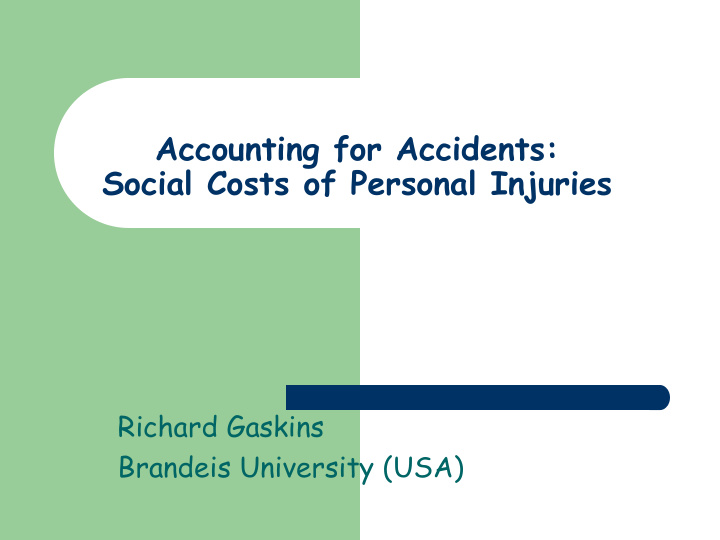



Accounting for Accidents: Social Costs of Personal Injuries Richard Gaskins Brandeis University (USA)
Report of the Royal Commission “The toll of personal injury is one of the disastrous incidents of social progress, and the statistically inevitable victims are entitled to receive a co-ordinated response from the nation as a whole.” (¶ 1)
Report of the Royal Commission “The toll of personal injury is one of the disastrous incidents of social progress, and the statistically inevitable victims are entitled to receive a co-ordinated response from the nation as a whole.” (¶ 1) est. 2003: NZ$6-7 billion annual costs
Levels of accounting Level 1: Social costs and remedies (L) Liabilities = “the toll of personal injury” (A) Assets = all public and private efforts to mitigate (L)
Levels of accounting Level 2: ACC claims and levies (l) liabilities = claims filed under ACC statute (a) assets = revenues from ACC levies/taxes
Levels of accounting Level 1: Social costs (NZ$6-7 billion annually) (L) Liabilities = “the toll of personal injury” (A) Assets = all public and private efforts to mitigate (L) Level 2: ACC accounts (l) liabilities = claims filed under ACC statute (a) assets = revenues from ACC levies/taxes
Moving between levels: (l) is a subset of (L) Level 1: Social costs (NZ$6-7 billion annually) (L) Liabilities = “the toll of personal injury” (A) Assets = all public and private efforts to mitigate (L) Level 2: ACC accounts (l) liabilities = claims filed under ACC statute (a) assets = revenues from ACC levies/taxes
How should we pay for ACC ? Level 2: reconciling (l) and (a) (l) liabilities = claims filed under ACC statute (a) assets = revenues from ACC levies/taxes Note: (l) is a subset of Level 1 “social costs” (L)
Shifting costs between (L) and (l): 3 guiding questions 1. Who caused it?
Shifting costs between (L) and (l): 3 guiding questions Who caused it? 1. Who was in a position to prevent it? 2.
Shifting costs between (L) and (l): 3 guiding questions Who caused it? 1. Who was in a position to prevent it? 2. Who is in a position to prevent it most 3. efficiently?
Shifting costs between (L) and (l): 3 guiding questions 1. Who caused it? (Whose fault was it?)
Shifting costs between (L) and (l): 3 guiding questions 2. Who was in a position to prevent (mitigate) it?
Report of the Royal Commission “People have begun to recognize that the accidents regularly befalling large numbers of their fellow citizens are due not so much to human error as to the complicated and uneasy environment which everybody tolerates for its apparent advantages. The risks are the risks of social progress….” (¶ 89)
Shifting costs between (L) and (l): 3 guiding questions 3. Who is in a position to prevent it most efficiently?
1969 White Paper “ Some say it is best to make the enterprise producing the accident liable for the risks. The losses should be spread among those whose activities create the risk of accidents. “…to the extent that the claims met by the fund result from injuries that can be attributed to identifiable activities, the claims should be a charge on those activities.” (¶ 205)
Competing frameworks: (L) Social costs v. (a) levies Level 1: Social costs (NZ$6-7 billion annually) (L) Liabilities = “the toll of personal injury” (A) Assets = all public and private efforts to mitigate (L) Level 2: ACC accounts (l) liabilities = claims filed under ACC statute (a) assets = revenues from ACC levies/taxes
Recommend
More recommend